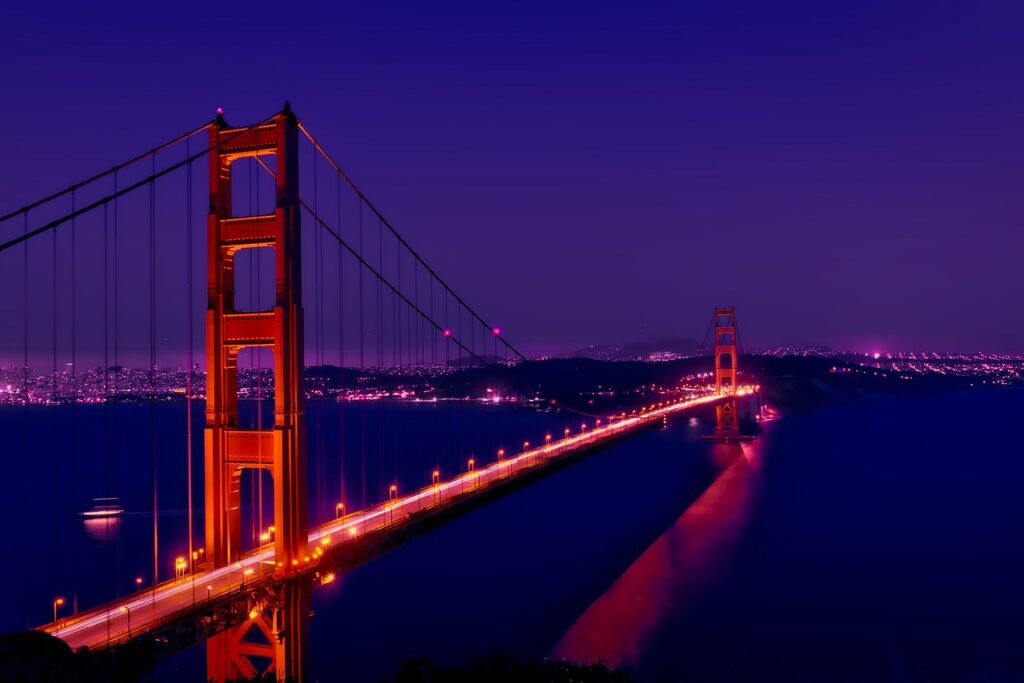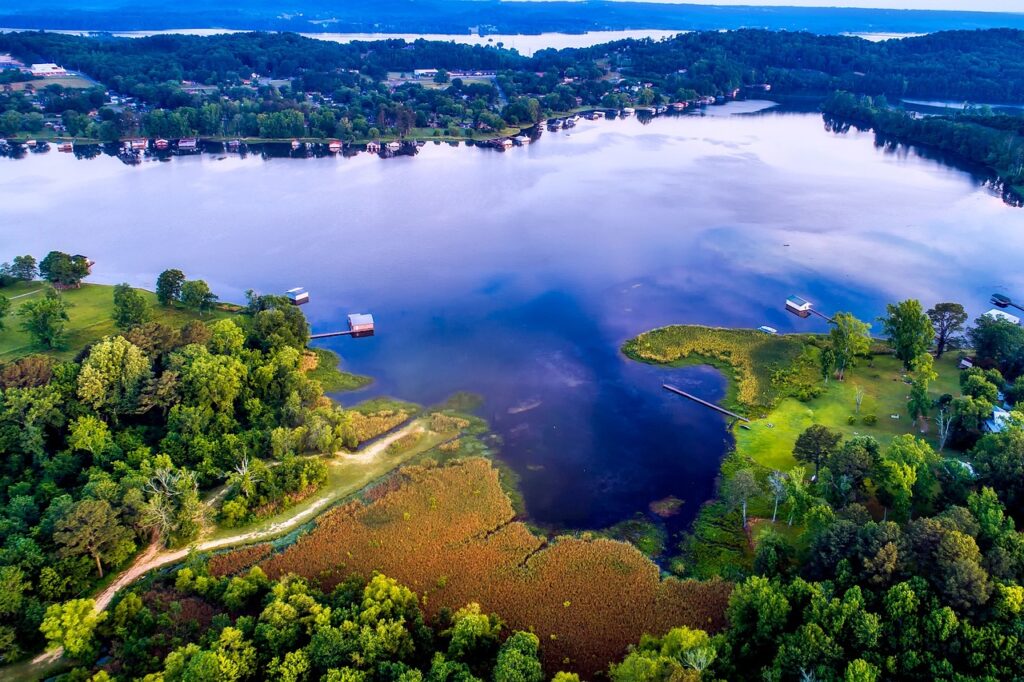Step into a world where engineering marvels embrace natural beauty in a dance of elegance and innovation. Welcome to the iconic Golden Gate Bridge in California. Stretching majestically across the entrance of San Francisco Bay, this suspension bridge is not just a feat of human ingenuity but a symbol of a city’s spirit.
With its towering orange towers and sweeping views of the Pacific, the Golden Gate Bridge beckons explorers and dreamers alike to step onto its golden pathway and embark on a journey that transcends time and captivates the soul. Join us as we unravel the enchanting tale of the Golden Gate Bridge – where history, art, and nature intertwine in a masterpiece that stands as a testament to the boundless possibilities of human achievement.
Golden Gate Bridge location:
The Golden Gate Bridge is located in the northern part of California, spanning the Golden Gate Strait. It’s at the entrance to the San Francisco Bay from the Pacific Ocean. The bridge connects the city of San Francisco to Marin County. The southern end of the bridge is situated in the Presidio neighborhood of San Francisco, while the northern end is located in the Marin Headlands. The iconic bridge is easily accessible from various points in San Francisco and is a major transportation artery in the region.
location In Google Map
History of Golden Gate Bridge:

Here is a brief history of the Golden Gate Bridge:
Early Proposals:
The idea of a bridge spanning the Golden Gate Strait, the entrance to the San Francisco Bay from the Pacific Ocean, was first proposed in the early 20th century. However, the challenging geography and strong currents in the strait made the project seem impractical.
Chief Engineer Joseph Strauss:
In 1921, engineer Joseph Strauss presented a preliminary proposal for a hybrid cantilever-suspension bridge, but it faced significant opposition due to its unimpressive design.
Design Competition:
A design competition was held in 1930 to select the best design for the bridge. The winning design, a graceful and elegant Art Deco style suspension bridge, was submitted by engineer Leon Moisseiff and architect Irving Morrow.
Construction Begins:
Construction of the Golden Gate Bridge began on January 5, 1933, during the Great Depression. Chief Engineer Joseph Strauss was replaced by Irving Morrow, and Charles Alton Ellis, a consulting engineer, played a crucial role in refining the design.
Construction Challenges:
The construction faced numerous challenges, including strong tides, frequent storms, and the depth of the channel. The use of a safety net under the bridge during construction saved the lives of 19 workers who became known as the “Halfway to Hell Club.”
Completion and Opening:
The Golden Gate Bridge was completed ahead of schedule and under budget. It opened to vehicular traffic on May 28, 1937, and at the time, it was the longest and tallest suspension bridge in the world.
Art Deco Design:
The bridge’s towers, painted in an International Orange color, were chosen for visibility in San Francisco’s frequent fog. The Art Deco elements, including the lighting and the stylized vertical fluting on the towers, contribute to the bridge’s aesthetic appeal.
Engineering Marvel:
The Golden Gate Bridge was considered an engineering marvel of its time, and its construction techniques, such as the use of a safety net, became models for future bridge projects. The bridge’s towers are 746 feet (227 meters) tall, and the total length of the main span is 4,200 feet (1,280 meters).
Maintenance and Upgrades:
Over the years, the bridge has undergone maintenance and retrofitting to enhance its earthquake resistance. It remains an important transportation link and a symbol of San Francisco.
Cultural Symbol:
The Golden Gate Bridge has become one of the most recognized symbols of San Francisco and the United States. It is a popular tourist attraction and an enduring symbol of engineering and architectural achievement.
Why is Golden Gate Bridge famous?
The Golden Gate Bridge is renowned for its iconic red-orange color, stunning architecture, and strategic location in San Francisco, California. Completed in 1937, it spans the Golden Gate Strait, connecting the city to Marin County. Its impressive 4,200-foot span made it the longest suspension bridge at the time.
The bridge’s distinctive Art Deco design, coupled with its breathtaking views of the Pacific Ocean, San Francisco Bay, and the city skyline, has made it a symbol of engineering prowess and a beloved cultural landmark. The Golden Gate Bridge attracts millions of visitors annually and is an enduring emblem of San Francisco.
Why is it called the Golden Gate?
The Golden Gate Bridge derives its name from the Golden Gate Strait, the entrance to the San Francisco Bay from the Pacific Ocean. The term “Golden Gate” was coined by John C. Frémont, an American military officer, and explorer, in 1846.
The name does not refer to the color of the bridge, as some might assume due to its distinctive orange hue. The International Orange color was actually selected for the bridge to enhance visibility and complement the natural surroundings, not because of the term “Golden Gate.”
The Golden Gate Strait earned its name due to the golden hues often seen in the sunlight that bathes the waters and the surrounding hills during sunrise and sunset. The name stuck, and when it came time to name the bridge that spans this iconic strait, “Golden Gate Bridge” seemed a fitting and poetic choice.
The color of golden gate bridge:
The official color of the Golden Gate Bridge is International Orange.” This distinctive hue was selected to enhance visibility and complement the natural surroundings of the bridge, including the often foggy conditions in the San Francisco Bay area. The color is a warm, reddish-orange tone that has become synonymous with the bridge’s iconic appearance. The use of International Orange has not only contributed to the bridge’s visibility but has also become a significant part of its aesthetic identity.
The length and height of Golden Gate Bridge:
The Golden Gate Bridge, an iconic suspension bridge in San Francisco, California, has the following dimensions:
Total Length:
The main span of the Golden Gate Bridge is 4,200 feet (about 1,280 meters), which makes it one of the longest suspension bridges in the world.
Tower Height:
The towers of the Golden Gate Bridge stand at a height of 746 feet (about 227 meters) above the water.
These impressive measurements contribute to the bridge’s iconic stature and its ability to span the entrance of the San Francisco Bay, providing a vital transportation link between San Francisco and Marin County.
How much golden gate bridge cost to build?
The construction cost of the Golden Gate Bridge was approximately $35 million (today’s value about $600 million). The construction cost of the structure was $27,125,000. The Engineering and Inspection cost was $2,050,000, Administrative and Preliminary Expenses $423,000. Other costs was $4,068,000 for Financing, and $1,334,000 in surplus.
Cost to cross Golden Gate Bridge:
Here is the toll rate when you cross the bridge. Create a FastTrack account to pay the toll here.
| Number of Axles(see chart) | FasTrak Toll | License Plate Account & One-Time Payment | Toll Invoice |
|---|---|---|---|
| 2 Axles/ Motorcycles | $8.75 | $9.00 | $9.75 |
| 3 Axles | $26.25 | $27.00 | $29.25 |
| 4 Axles | $35.00 | $36.00 | $39.00 |
| 5 Axles | $43.75 | $45.00 | $48.75 |
| 6 Axles | $52.50 | $54.00 | $58.50 |
| 7 Axles or More | $61.25 | $63.00 | $68.25 |
| Carpools | $6.75 | n/a | n/a |
Golden Gate Bridge View Points:

When visiting the Golden Gate Bridge, there are several breathtaking viewpoints that offer stunning perspectives of this iconic landmark. Here are some must-visit view points:
Battery Spencer:
- Battery Spencer provides an elevated view of the Golden Gate Bridge and the San Francisco skyline. The panoramic vistas make it a popular spot for both day and night photography. The address of the spot is Conzelman Rd, Sausalito, CA 94965.
Fort Point:
- Situated just beneath the southern end of the Golden Gate Bridge, Fort Point offers unique angles for photographing the bridge. Explore the historic military fort and capture the bridge against the backdrop of the bay.
Marin Headlands:
- The Marin Headlands, in general, provide multiple viewpoints with varying elevations. Hawk Hill and the various pull-offs along Conzelman Road offer sweeping views of the bridge, San Francisco, and the Pacific Ocean.
Golden Gate Overlook:
- Located in the Presidio, the Golden Gate Overlook offers a fantastic view of the bridge framed by cypress trees. It’s a great spot to relax and take in the beauty of the surroundings.
Crissy Field:
- This waterfront park not only offers a green space for picnics and recreation but also provides a beautiful view of the Golden Gate Bridge. Capture the bridge against the backdrop of the bay and the city skyline.
Baker Beach:
- Enjoy a more relaxed atmosphere at Baker Beach while still having a great view of the Golden Gate Bridge. This beach offers a unique perspective, especially during sunset.
Land’s End Lookout:
- Head to Land’s End for dramatic cliffside views of the bridge. The Land’s End Trail takes you to the lookout, and along the way, you can explore scenic coastal trails.
Kirby Cove:
- For a unique view from below, consider Kirby Cove. This spot requires a hike, but the reward is a secluded beach with a close-up view of the bridge.
Alcatraz Island:
- If you take a ferry to Alcatraz Island, you’ll get a different angle of the Golden Gate Bridge. The view from the island provides a contrasting perspective against the historical backdrop.
Ghirardelli Square:
- For a view from a distance in a more urban setting, Ghirardelli Square offers a unique perspective. Enjoy the ambiance of this historic area while taking in the iconic sight of the bridge.
What to Do During Your Visit to the Golden Gate Bridge:

Visiting the world-renowned Golden Gate Bridge promises a unique experience for all enthusiasts. Whether you’re into hiking, walking, biking, shopping, or simply soaking in the majestic views, there’s something for everyone at this iconic landmark.
Welcome Center Exploration:
Begin your journey at the Golden Gate Bridge Welcome Center, open daily from 9:00 a.m. to 6:00 p.m. This hub serves as the first on-site center dedicated to unraveling the tales of the Golden Gate Bridge. Offering historical insights and orientation services, the Welcome Center also boasts high-quality commemorative merchandise. Dive into the rich history of the bridge and marvel at the original 12-foot stainless steel Bridge “test tower” used in 1933.
Onsite Exhibits:
Delve into the history, science, and engineering marvels behind the Golden Gate Bridge at the onsite exhibits. Located just outside the Welcome Center in the Plaza, these exhibits provide an interactive and stationary journey through the bridge’s construction. Venture into an old bunker housing some of these exhibits for an immersive experience.
Free Walking Tour:
Embark on a knowledge-filled journey with free walking tours offered by San Francisco City Guides every Thursday and Sunday. Dive deep into the history of the Golden Gate Bridge with these tours with a non-profit organization associated with the San Francisco Public Library. For more information and the tour schedule, check out the San Francisco City Guides website.
Whether you’re captivated by the breathtaking views, fascinated by the engineering prowess, or eager to unravel the bridge’s storied past, your visit to the Golden Gate Bridge promises to be an unforgettable experience. Contact the Welcome Center at 415-426-5220 or [email protected] for more details and to enhance your exploration. Don’t miss the chance to make memories and take home a piece of this iconic structure through unique souvenirs and educational experiences. Here is a a-z post about the best vacation spots in California.


